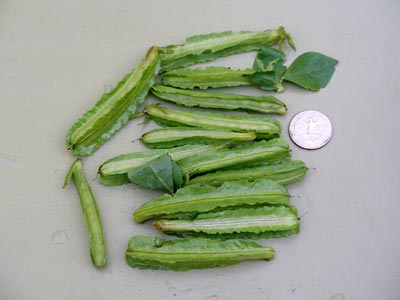Bleak, a small, elongated, white-fleshed fishof the same family as minnows and carp, abundant in lakes and quiet waterways. Its scales, which are thin and silvery, come away easily. The flesh of the pond bleak is of poor quality but that of the river variety is fairly good, although it is full of little bones. It is about 15 cm (6 inches) long and invariably served fried. It may also be called able though this is actually a different fish. May be mistaken for the able or gardon.
Yellow sweet clover, bird's foot trefoil. A leguminous plant the leaves and flowers of which, when dried, have a pleasant aroma. This delicate herb is high in carotene and vitamin C. In order to preserve its fragrance, it should never be more than briefly parboiled. Can be used in marinades, salads, custard dishes and clear soups to add aroma. It can be used to stuff rabbit. In Switzerland, it is used to make herbal tea. Some cheeses, notably the German cow’s milk Schabzieger and curd cheese are flavoured with the yellow flowers.

Asparagus pea. Winged bean. A thin, green, rectangular pod, the fruit of a leguminous plant with a flower similar to a sweet pea, eaten young in the same way as mange-tout. Nothing whatever to do with asparagus bean.

Monkfish (US: angler fish). A fish with a sweet flavour and succulent firm flesh but with the ugliest appearance imaginable. It is found in the Mediterranean and Atlantic, in coastal waters of north western Europe. It can be recognised by its large head and fan-shaped fins. The fins and the operculum are spiny. It can be eaten fried or in soup. The larger fish often have better flavour. It has a hideous head, which is why it is usually displayed without it, and a muddy colour. It is known as the anglerfish as it bears on its head a 'rod' and 'lure' which attract its prey. The meat of the tail is sweet and succulent - almost like lobster meat, entirely compensating for is appearance. The flavour may well be assisted by its own diet which is high in shellfish. The best monkfish are Lophius piscatorius and the similar Lophius budegassa, the favourite of the Spanish. American monkfish or goosefish (Lophius americanus) is considered inferior, while New Zealand monkfish (Kathetostoma giganteum) is related to the stargazer and is only fit for soup.
Burbot. A fish with the appearance of an eel, in which manner it is cooked.
A gregarious relation of the carp. It is found in the upper reaches of rivers, where it likes fast-moving water so may be found around piers or bridges of where currents speed around obstructions in the water. Its mouth is designed for scraping algal growths from stones. The flesh is tasty but has many bones which discourages people from eating it.

Grey mullet, the commonest and largest of the grey mullet (US: striped mullet) family. It is a silver, shoal-living fish pointed with dark grey which feeds on seaweed and plankton near the muddy bottom in estuaries and coastal waters. This can effect its flavour. However, a good grey mullet, caught in clean water, is round-bodied and has creamy white flesh and good flavour with good keeping capabilities. It must be thoroughly scaled before eating. Varieties are found all over the world. The roe is used for taramasalata, botargo, boutargue.